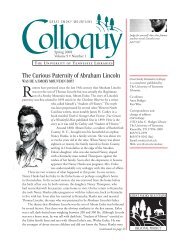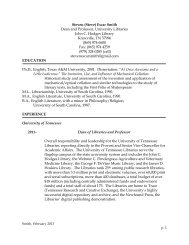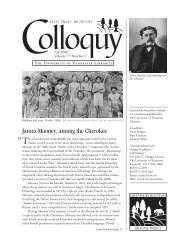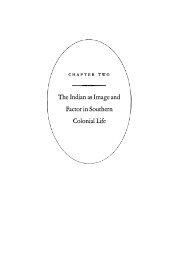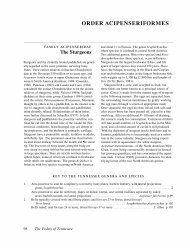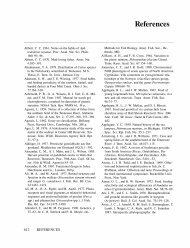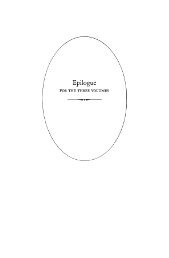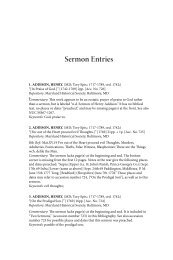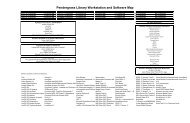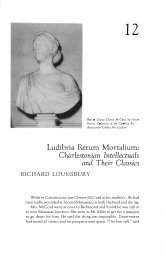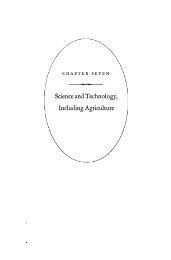Literature, Principally Belletristic - University of Tennessee, Knoxville
Literature, Principally Belletristic - University of Tennessee, Knoxville
Literature, Principally Belletristic - University of Tennessee, Knoxville
Create successful ePaper yourself
Turn your PDF publications into a flip-book with our unique Google optimized e-Paper software.
· INTELLECTUAL LIFE IN THE COLONIAL SOUTH '<br />
a lively inventiveness and almost urbane wit which makes adolescent<br />
authorship doubtful. The public clearly enjoyed these essays, incidentally,<br />
especially the mock debates between the Monitor and his severe critic<br />
ZoilUS.195<br />
Not all the "Monitor" pieces are satiric. No. 10 is on "Musick and<br />
Harmony," No. I I on the press as an auxiliary <strong>of</strong> the pulpit. Later ones<br />
do seem to become increasingly tongue-in-cheek or bitingly ironic. At any<br />
rate, they seem to be the most original group <strong>of</strong> essays in the first thirty<br />
years <strong>of</strong> the Virginia Gazette's history.196<br />
In a sense the Davies-Dymocke literary controversy <strong>of</strong> 1752 is also an<br />
essay series, but it has been discussed frequently in several earlier contexts,<br />
such as the satiric. It is beneath the surface, at least in part, a serious discussion<br />
<strong>of</strong> critical standards and literary tastes. Dymocke is usually sound<br />
in his taste but so bent on humiliating that he takes lines or images unfairly<br />
out <strong>of</strong> context. Davies is conscious <strong>of</strong> his own weaknesses and<br />
freely admits them but replies sharply where Dymocke is unfair. All together<br />
the exchange represents educated men debating aesthetic principles,<br />
fairly or unfairly, in the columns <strong>of</strong> this little newspaper in a southern<br />
colony.<br />
Perhaps the most intriguing and even best-written <strong>of</strong> Virginia essay<br />
series is the 1756-1757 "Centinel" group, <strong>of</strong> which only No. X now<br />
survives in a known issue <strong>of</strong> the Gazette, that <strong>of</strong> September 3, 1756.<br />
Fortunately numbers I, II ( ? ), III, IX, XI, XVI, XVII, XVIII, and XIX<br />
were reprinted in issues <strong>of</strong> the New York Gazette (six), the Maryland<br />
Gazette (one or two ), the New Hampshire Gazette (two), the Boston<br />
Evening Post (four), and the Pennsylvania Gazette (one). No. X, which<br />
Worthington C. Ford saw as an attack on George Washington, has been<br />
discussed in at least one critical essay, and J.A. leo lemay, who once believed<br />
he had evidence pointing to the Reverend James Maury as author<br />
<strong>of</strong> this and at least some others in the series, has on reconsideration and<br />
some new evidence come to the conclusion that the Centinel papers were<br />
written not by the Anglican parson, but by the Presbyterian Samuel<br />
Davies.197 Prose rhetoric and poetic imagery have some resemblance to<br />
Davies', and Lemay finds that in Centinel No. XIX, extant in the Boston<br />
Evening Post <strong>of</strong> April II, 1757, references to and quotations from a<br />
"Manuscript Sermon" can be positively identified as the sermon Davies<br />
preached at Henrico January I, 1757. Both X and XIX are apparently<br />
attacks on the soldiers fighting against the French. Lemay analyzes the<br />
group <strong>of</strong> essays as a whole for reasoning, argument, language, and imagery,<br />
and above all rhetorical style. He concludes that Davies was at<br />
least the principal, if not the sale, author <strong>of</strong> the series. This writer is not<br />
entirely convinced, for a number <strong>of</strong> educated men might have seen



